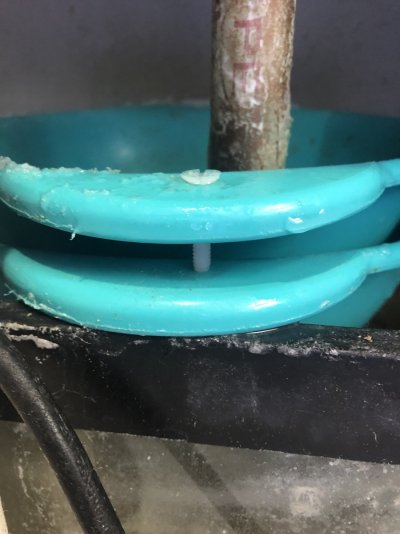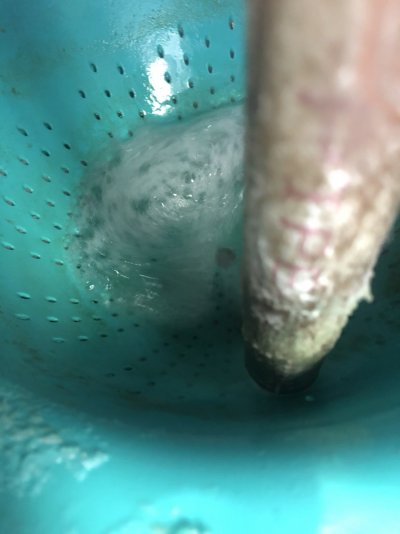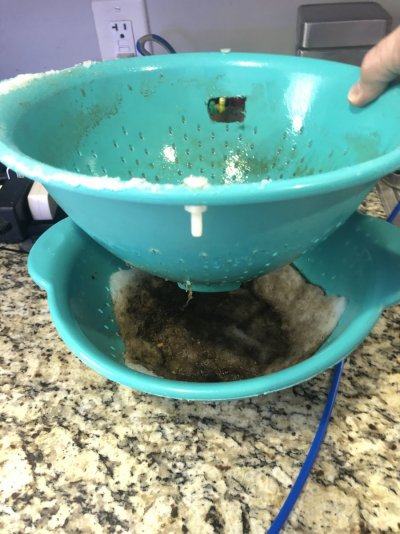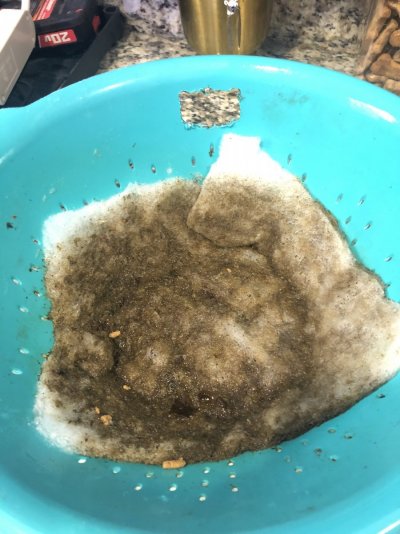I’m not trying to pick a side. Just looking to understand how to best serve my needs.I would trust Randy over Seachem anyday.
Navigation
Install the app
How to install the app on iOS
Follow along with the video below to see how to install our site as a web app on your home screen.
Note: This feature may not be available in some browsers.
More options
You are using an out of date browser. It may not display this or other websites correctly.
You should upgrade or use an alternative browser.
You should upgrade or use an alternative browser.
Is it feasible to remove the skimmer? Could it solve the decades-long problem of nutrient accumulation?
- Thread starter Belgian Anthias
- Start date
- Tagged users None
Randy Holmes-Farley
Reef Chemist
View Badges
Staff member
Super Moderator
Excellence Award
Expert Contributor
Article Contributor
R2R Research
My Tank Thread
- Joined
- Sep 5, 2014
- Messages
- 67,509
- Reaction score
- 63,933
I’m not trying to pick a side. Just looking to understand how to best serve my needs.
Phosguard is fine, IMO, in low amounts, well rinsed, and if you stop using it if leathers close up.
Leathers not my flavor. Wasn’t in the 80s either.Phosguard is fine, IMO, in low amounts, well rinsed, and if you stop using it if leathers close up.
Couldn’t agree moreAfter taking one look or smell at what a skimmer pulls out of the water, I don't know how anyone could run a tank without one.
Following up on my previous post...
It's been 2 weeks since I sidelined my skimmer.
As noted previously, my nitrates were consistently between 20-25 (Hanna HR nitrate checker) for 4-6 months.
Removed skimmer, and after 5 days, nitrates dropped to 13; 5 days later down to 6, and 5 days after that down to 0.1.
I removed carbon and purigen at the same time as skimmer coming off line, but that shouldn't have had an effect on the nitrates.
Refugium still running same times.
Not sure why... would love to hear others thoughts on this.
It's been 2 weeks since I sidelined my skimmer.
As noted previously, my nitrates were consistently between 20-25 (Hanna HR nitrate checker) for 4-6 months.
Removed skimmer, and after 5 days, nitrates dropped to 13; 5 days later down to 6, and 5 days after that down to 0.1.
I removed carbon and purigen at the same time as skimmer coming off line, but that shouldn't have had an effect on the nitrates.
Refugium still running same times.
Not sure why... would love to hear others thoughts on this.
Don’t use one and don’t miss it. My colander filter creates plenty of foam fractioning and enhances the Walmart poly’s ability to remove detritus.
Attachments
As does the Government of South Australia. https://www.sahealth.sa.gov.au/wps/...me/palytoxin+poisoning+marine+aquarium+safetyFolks need only think "Red Tide" to worry about toxins in marine environments.
I've read where others have pointed out that rocks kept with tanks containing Zoas might contain toxins later released when establishing a new tank. No clue how accurate or misinformed this might be but I've concluded that Zoas won't be in my tank which likely wasn't happening since I don't like them anyway. Reminds me of floral arrangement of colorful sunflowers.As does the Government of South Australia. https://www.sahealth.sa.gov.au/wps/...me/palytoxin+poisoning+marine+aquarium+safety
In a small closed environment, a marine aquarium, on should be concerned about all biotoxins, not only those dangerous for humans. Biotoxins are produced by most organisms, bacteria, algae, dino's, cyano's, diatom enz..
For humans dangerous maitotoxins are produced by marine dinoflaggellates.
Maitotoxins were found in the surgeonfish Ctenochaetus striatus. The fish is part of the so-called ciguatera food chain. The chain starts with consuming poisons present in dinoflagellates, in this case ciguatoxin and maitotoxin present in the marine organism, Gambierdiscus toxicus, which mainly grows in and around coral reefs, especially in the Caribbean. The higher up the food chain, the more concentrated the poison is.
Most biotoxins are organic compounds containing nitrogen and are biodegradabel.
One may expect biotoxins available in the water column are removed by a skimmer or and GAC. But some of the most dangerous for humans are left behind.
How biotoxins become available in the water column?
In a biofilm based biofilter it takes 1-3 days to degrade dangerous saxitoxins. In open water for to degrade saxitoxins it may take about 1 month. Some saxitoxins may degrade ( upgrade?) into even more toxic compounds before being degraded to non toxic.
Filter feeders and grazers consuming photo-autotrophs producing biotoxins may store the biotoxins, some use them as a defence mechanismn against other predators. These organisms also contain bacteria ( enzyms) to degrade biotoxins keeping them within a for the organismn acceptable range.
In an aquarium a logic place to find biotoxins degrading bacteria is in GAC, It has been shown GAC is the best medium to use for a biotoxin degrading biofilter. Removing GAC in time, before it becomes a biofilter, will also remove most biotoxins.
If it is about removing and or degrading biotoxins one may also think about investing in a good powerfull UV unit , which is not selective .
Since the sixties GAC is used at the end of the filter chain for removing biotoxins and fennols. The performance of GAC is well documented.
Now also polymers are available, some claiming to remove all organic compounds ( not being selective) , better performing as GAC, but we do not have good independent information about polymers now used in the aquarium trade.
For humans dangerous maitotoxins are produced by marine dinoflaggellates.
Maitotoxins were found in the surgeonfish Ctenochaetus striatus. The fish is part of the so-called ciguatera food chain. The chain starts with consuming poisons present in dinoflagellates, in this case ciguatoxin and maitotoxin present in the marine organism, Gambierdiscus toxicus, which mainly grows in and around coral reefs, especially in the Caribbean. The higher up the food chain, the more concentrated the poison is.
Most biotoxins are organic compounds containing nitrogen and are biodegradabel.
One may expect biotoxins available in the water column are removed by a skimmer or and GAC. But some of the most dangerous for humans are left behind.
How biotoxins become available in the water column?
In a biofilm based biofilter it takes 1-3 days to degrade dangerous saxitoxins. In open water for to degrade saxitoxins it may take about 1 month. Some saxitoxins may degrade ( upgrade?) into even more toxic compounds before being degraded to non toxic.
Filter feeders and grazers consuming photo-autotrophs producing biotoxins may store the biotoxins, some use them as a defence mechanismn against other predators. These organisms also contain bacteria ( enzyms) to degrade biotoxins keeping them within a for the organismn acceptable range.
In an aquarium a logic place to find biotoxins degrading bacteria is in GAC, It has been shown GAC is the best medium to use for a biotoxin degrading biofilter. Removing GAC in time, before it becomes a biofilter, will also remove most biotoxins.
If it is about removing and or degrading biotoxins one may also think about investing in a good powerfull UV unit , which is not selective .
Since the sixties GAC is used at the end of the filter chain for removing biotoxins and fennols. The performance of GAC is well documented.
Now also polymers are available, some claiming to remove all organic compounds ( not being selective) , better performing as GAC, but we do not have good independent information about polymers now used in the aquarium trade.
It not only about the Zoa's or they must have been contaminated before introduction. A toxic chain may have been created within the system with other organisms being responsible for the toxins production.I've read where others have pointed out that rocks kept with tanks containing Zoas might contain toxins later released when establishing a new tank. No clue how accurate or misinformed this might be but I've concluded that Zoas won't be in my tank which likely wasn't happening since I don't like them anyway. Reminds me of floral arrangement of colorful sunflowers.
Don't see how 10% bimonthly removes these toxins faster than they become lethal in proportion or are introduced through the organisms we keep. Were toxins truly an issue then only solution is what Discus breeders do and change the water 100% daily because they think they should mimic Malaysian breeders with perfect Discus water locally. You'd think carbon would remove some of these toxins and perhaps other means more efficient than buckets spilled on our floors then having to deal with angry wives.
Randy Holmes-Farley
Reef Chemist
View Badges
Staff member
Super Moderator
Excellence Award
Expert Contributor
Article Contributor
R2R Research
My Tank Thread
- Joined
- Sep 5, 2014
- Messages
- 67,509
- Reaction score
- 63,933
Don't see how 10% bimonthly removes these toxins faster than they become lethal in proportion or are introduced through the organisms we keep. Were toxins truly an issue then only solution is what Discus breeders do and change the water 100% daily because they think they should mimic Malaysian breeders with perfect Discus water locally. You'd think carbon would remove some of these toxins and perhaps other means more efficient than buckets spilled on our floors then having to deal with angry wives.
It's all speculation about if and how fast such toxins may accumulate and remain in water, but it is easy to see what the effect is. It is not insignificant.
if 2 ug/L of toxin is added daily, in a year without water changes you reach 720 ug/L and it keeps rising.
In a year with a 10% change every 14 days, you reach 237 ug/l, and doesn't get much higher, ever.
Assuming only 2 ug/L daily. What happens at 2.5? Point is we don’t know what is added yet it seems 10% widely expected. At a minimum, one would be to be able to test fit it, derive the daily input then calculate the percentage and frequency of water changes needed to stay below the toxic level we still haven’t defined.It's all speculation about if and how fast such toxins may accumulate and remain in water, but it is easy to see what the effect is. It is not insignificant.
if 2 ug/L of toxin is added daily, in a year without water changes you reach 720 ug/L and it keeps rising.
In a year with a 10% change every 14 days, you reach 237 ug/l, and doesn't get much higher, ever.
Wouldn’t it be easier to determine if there are means of scrubbing to toxins out vs dilution as a solution? Carbon must remove some. Likely other resins exist that can be utilized. Otherwise we are solving that we haven’t concluded needs solving yet not sure exactly if our efforts actually work.
Randy Holmes-Farley
Reef Chemist
View Badges
Staff member
Super Moderator
Excellence Award
Expert Contributor
Article Contributor
R2R Research
My Tank Thread
- Joined
- Sep 5, 2014
- Messages
- 67,509
- Reaction score
- 63,933
Assuming only 2 ug/L daily. What happens at 2.5? Point is we don’t know what is added yet it seems 10% widely expected. At a minimum, one would be to be able to test fit it, derive the daily input then calculate the percentage and frequency of water changes needed to stay below the toxic level we still haven’t defined.
Wouldn’t it be easier to determine if there are means of scrubbing to toxins out vs dilution as a solution? Carbon must remove some. Likely other resins exist that can be utilized. Otherwise we are solving that we haven’t concluded needs solving yet not sure exactly if our efforts actually work.
The ratio after 1 year, showing 1/3 as much with water changes as without, is completely independent of ANYTHING except the number and amount of water changes.
Thus, the hypothesis that biweekly 10% changes cannot do much is easily quantified, and a 67% drop does not seem like nothing to me.
Understood but highly dependent on how quickly toxins are added. Why 10% bimonthly not controlling nitrates. Something else needed to remove the bulk of it.The ratio after 1 year, showing 1/3 as much with water changes as without, is completely independent of ANYTHING except the number and amount of water changes.
Thus, the hypothesis that biweekly 10% changes cannot do much is easily quantified, and a 67% drop does not seem like nothing to me.
Do ICP test identify all potential toxins and if not then for those it does then either adjusting those water changes or finding other means of exports the solution. Just don’t see how the standard recommended 10% resolving an issue we don’t know exists or to the extent it does exist or what level becomes problematic.
Randy Holmes-Farley
Reef Chemist
View Badges
Staff member
Super Moderator
Excellence Award
Expert Contributor
Article Contributor
R2R Research
My Tank Thread
- Joined
- Sep 5, 2014
- Messages
- 67,509
- Reaction score
- 63,933
Understood but highly dependent on how quickly toxins are added. Why 10% bimonthly not controlling nitrates. Something else needed to remove the bulk of it.
Nitrate will be 67% lower than without those changes.
Is that enough? maybe, maybe not.
Same for anything else it exports.
If it is not enough, and if you have a way to export more, then that seems appropriate.
That’s my main point about the arbitrary 10% bimonthly often quoted. Each system being unique and if WC the chosen path then it needs to be altered to meet the problem. Problem we don’t necessarily know for a fact we have when it comes to toxins. I get it. Better safe than sorry but if that’s the goal then perhaps 10% not enough.Nitrate will be 67% lower than without those changes.
Is that enough? maybe, maybe not.
Same for anything else it exports.
If it is not enough, and if you have a way to export more, then that seems appropriate.
Randy Holmes-Farley
Reef Chemist
View Badges
Staff member
Super Moderator
Excellence Award
Expert Contributor
Article Contributor
R2R Research
My Tank Thread
- Joined
- Sep 5, 2014
- Messages
- 67,509
- Reaction score
- 63,933
That’s my main point about the arbitrary 10% bimonthly often quoted. Each system being unique and if WC the chosen path then it needs to be altered to meet the problem. Problem we don’t necessarily know for a fact we have when it comes to toxins. I get it. Better safe than sorry but if that’s the goal then perhaps 10% not enough.
It may not be enough. I changed 1% daily. If that useful? I think so. It drops accumulating things by 74%. Is it enough to prevent all possible accumulations? No.
Water changes to prevent accumulation?
Total daily nitrate production is 2 ppm, 1ppm is accumulating daily.
Changing 50% water daily the first day will remove 0.5 ppm, the next day 50% of 1.5% ppm, the next day 50% of 1.75 ppm
Due to accumulation the level will increase until the water change will remove the daily nitrate overproduction, in this case when a level of 2ppm is reached. How many days it will take?
if 1% is changed daily the level must increase to reach 100ppm to prevent accumulation.
Biotoxins are produced constantly , toxins are released and toxins producing organisms are consumed, toxins are stored in non toxin producing organisms, water changes or not. If one changes 1% water daily, how long will it take for the system to contain the same amount of toxin producing and consuming organisms?
The accumulated toxins are released when the organism dies. They may be bio degraded, or not.
Total daily nitrate production is 2 ppm, 1ppm is accumulating daily.
Changing 50% water daily the first day will remove 0.5 ppm, the next day 50% of 1.5% ppm, the next day 50% of 1.75 ppm
Due to accumulation the level will increase until the water change will remove the daily nitrate overproduction, in this case when a level of 2ppm is reached. How many days it will take?
if 1% is changed daily the level must increase to reach 100ppm to prevent accumulation.
Biotoxins are produced constantly , toxins are released and toxins producing organisms are consumed, toxins are stored in non toxin producing organisms, water changes or not. If one changes 1% water daily, how long will it take for the system to contain the same amount of toxin producing and consuming organisms?
The accumulated toxins are released when the organism dies. They may be bio degraded, or not.
Last edited:
Randy Holmes-Farley
Reef Chemist
View Badges
Staff member
Super Moderator
Excellence Award
Expert Contributor
Article Contributor
R2R Research
My Tank Thread
- Joined
- Sep 5, 2014
- Messages
- 67,509
- Reaction score
- 63,933
Water changes to prevent accumulation?
Total daily nitrate production is 2 ppm, 1ppm is accumulating daily.
Changing 50% water daily the first day will remove 0.5 ppm, the next day 50% of 1.5% ppm, the next day 50% of 1.75 ppm
Due to accumulation the level will increase until the water change will remove the daily nitrate overproduction, in this case when a level of 2ppm is reached. How many days it will take?
if 1% is changed daily the level must increase to reach 100ppm to prevent accumulation.
BioToxins are produced all day long , toxins are released and toxins producing organisms are consumed, toxins are stored in non toxin producing organisms, water changes or not. If one changes 1% water daily, how long will it take for the system to contain the same amount of toxin producing and consuming organisms?
The accumulated toxins are released when the organism dies. They may be bio degraded, or not.
Not hard to see the clear effect, but I'm not sure 1 ppm per day is a good value since reef tanks without water changes rarely accumulate 365 ppm in a year. I used 0.1 ppm per day below, but the large effect of a water change is clear, its just the values along the axis that change when making different accumulation rate changes.
Figure 2. Nitrate concentration as a function of time when performing water changes of 0% (no changes), 7.5%, 15% and 30% of the total volume each month. In this example, nitrate is present at 0 ppm at the start, and is accumulated at a rate of 0.1 ppm per day when no water is changed.
Similar threads
- Replies
- 39
- Views
- 1,057
- Replies
- 17
- Views
- 324
- Replies
- 2
- Views
- 67





















